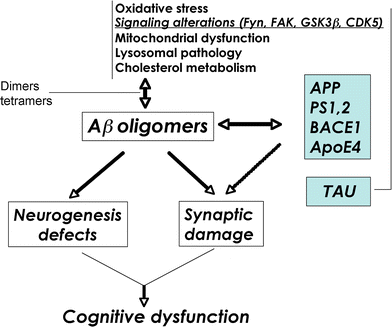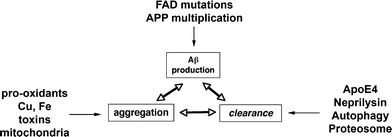APP transgenic modeling of Alzheimer's disease: mechanisms of neurodegeneration and aberrant neurogenesis
- PMID: 20091183
- PMCID: PMC2847155
- DOI: 10.1007/s00429-009-0232-6
APP transgenic modeling of Alzheimer's disease: mechanisms of neurodegeneration and aberrant neurogenesis
Abstract
Neurodegenerative disorders of the aging population affect over 5 million people in the US and Europe alone. The common feature is the progressive accumulation of misfolded proteins with the formation of toxic oligomers. Alzheimer's disease (AD) is characterized by cognitive impairment, progressive degeneration of neuronal populations in the neocortex and limbic system, and formation of amyloid plaques and neurofibrillary tangles. Amyloid-beta (Abeta) is the product of proteolysis of amyloid precursor protein (APP) by beta and gamma-secretase enzymes. The neurodegenerative process in AD initiates with axonal and synaptic damage and is associated with progressive accumulation of toxic Abeta oligomers in the intracellular and extracellular space. In addition, neurodegeneration in AD is associated with alterations in neurogenesis. Abeta accumulation is the consequence of an altered balance between protein synthesis, aggregation rate, and clearance. Identification of genetic mutations in APP associated with familial forms of AD and gene polymorphisms associated with the more common sporadic variants of AD has led to the development of transgenic (tg) and knock out rodents as well as viral vector driven models of AD. While APP tg murine models with mutations in the N- and C-terminal flanking regions of Abeta are characterized by increased Abeta production with plaque formation, mutations in the mid-segment of Abeta result in increased formation of oligomers, and mutations toward the C-terminus (E22Q) segment results in amyloid angiopathy. Similar to AD, in APP tg models bearing familial mutations, formation of Abeta oligomers results in defective plasticity in the perforant pathway, selective neuronal degeneration, and alterations in neurogenesis. Promising results have been obtained utilizing APP tg models of AD to develop therapies including the use of beta- and gamma-secretase inhibitors, immunization, and stimulating neurogenesis.
Figures







Similar articles
-
[Alzheimer disease: cellular and molecular aspects].Bull Mem Acad R Med Belg. 2005;160(10-12):445-9; discussion 450-1. Bull Mem Acad R Med Belg. 2005. PMID: 16768248 French.
-
Alzheimer's disease.Subcell Biochem. 2012;65:329-52. doi: 10.1007/978-94-007-5416-4_14. Subcell Biochem. 2012. PMID: 23225010 Review.
-
Behavioral and neural network abnormalities in human APP transgenic mice resemble those of App knock-in mice and are modulated by familial Alzheimer's disease mutations but not by inhibition of BACE1.Mol Neurodegener. 2020 Sep 14;15(1):53. doi: 10.1186/s13024-020-00393-5. Mol Neurodegener. 2020. PMID: 32921309 Free PMC article.
-
Complement C3 deficiency leads to accelerated amyloid beta plaque deposition and neurodegeneration and modulation of the microglia/macrophage phenotype in amyloid precursor protein transgenic mice.J Neurosci. 2008 Jun 18;28(25):6333-41. doi: 10.1523/JNEUROSCI.0829-08.2008. J Neurosci. 2008. PMID: 18562603 Free PMC article.
-
[The beta-amyloid cascade hypothesis: a sequence of events leading to neurodegeneration in Alzheimer's disease].Neurol Neurochir Pol. 2004 Sep-Oct;38(5):405-11. Neurol Neurochir Pol. 2004. PMID: 15565529 Review. Polish.
Cited by
-
Protein phosphatases and Alzheimer's disease.Prog Mol Biol Transl Sci. 2012;106:343-79. doi: 10.1016/B978-0-12-396456-4.00012-2. Prog Mol Biol Transl Sci. 2012. PMID: 22340724 Free PMC article. Review.
-
The multiplicity of action of cannabinoids: implications for treating neurodegeneration.CNS Neurosci Ther. 2011 Dec;17(6):637-44. doi: 10.1111/j.1755-5949.2010.00195.x. Epub 2010 Sep 28. CNS Neurosci Ther. 2011. PMID: 20875047 Free PMC article. Review.
-
Genetic Dissection of Alzheimer's Disease Using Drosophila Models.Int J Mol Sci. 2020 Jan 30;21(3):884. doi: 10.3390/ijms21030884. Int J Mol Sci. 2020. PMID: 32019113 Free PMC article. Review.
-
The Beta-amyloid protein of Alzheimer's disease: communication breakdown by modifying the neuronal cytoskeleton.Int J Alzheimers Dis. 2013;2013:910502. doi: 10.1155/2013/910502. Epub 2013 Dec 12. Int J Alzheimers Dis. 2013. PMID: 24416616 Free PMC article. Review.
-
Molecular mechanisms of neurodegeneration in Alzheimer's disease.Hum Mol Genet. 2010 Apr 15;19(R1):R12-20. doi: 10.1093/hmg/ddq160. Epub 2010 Apr 22. Hum Mol Genet. 2010. PMID: 20413653 Free PMC article. Review.
References
-
- Ahlijanian MK, Barrezueta NX, Williams RD, Jakowski A, Kowsz KP, McCarthy S, Coskran T, Carlo A, Seymour PA, Burkhardt JE, Nelson RB, McNeish JD. Hyperphosphorylated tau and neurofilament and cytoskeletal disruptions in mice overexpressing human p25, an activator of cdk5. Proc Natl Acad Sci USA. 2000;97:2910–2915. - PMC - PubMed
-
- Andra K, Abramowski D, Duke M, Probst A, Wiederholt K, Burki K, Goedert M, Sommer B, Staufenbiel M. Expression of APP in transgenic mice: a comparison of neuron-specific promoters. Neurobiol Aging. 1996;17:183–190. - PubMed
-
- Bertoli-Avella AM, Oostra BA, Heutink P. Chasing genes in Alzheimer’s and Parkinson’s disease. Hum Genet. 2004;114:413–438. - PubMed
Publication types
MeSH terms
Substances
Grants and funding
LinkOut - more resources
Full Text Sources
Medical
Miscellaneous

